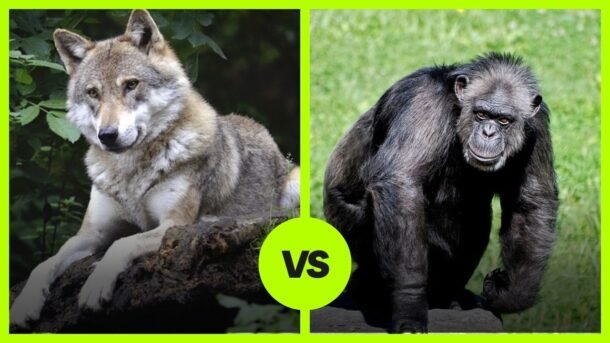First, let’s talk about Team Wolf. Wolves are pack animals, but for the sake of this argument, we’re considering a one-on-one fight. Adult wolves can weigh anywhere from 70 to 180 pounds, depending on the subspecies. They’ve got powerful jaws capable of snapping bones and their teeth can exert a crushing pressure of around 1,500 pounds per square inch (psi). Plus, they’re fast, like, really fast—reaching speeds of up to 40 mph in short bursts.
On the other hand, we’ve got Team Chimpanzee. Adult male chimps weigh between 90 and 130 pounds, generally. Don’t let their lanky look fool you; these guys are freakishly strong. I’m talking about 5-8 times stronger than an average human! Chimps have powerful arms and hands, which they can use to manipulate objects and, of course, to hit hard. They’ve also got teeth that are sharp but not as specialized for biting through flesh and bone like a wolf’s.
The Tactics
Wolves’ prowess in hunting is a key factor that could significantly influence their combat abilities in a hypothetical fight against a chimpanzee.

These canines are not just predators; they are strategic hunters, adept at taking down prey much larger and stronger than themselves. This hunting technique involves a combination of endurance, strength, and tactical coordination, even when hunting individually.
- Stalking and Ambush Tactics: Wolves are masters of the stalk-and-ambush technique. They can move stealthily and position themselves strategically before launching a swift and decisive attack. This skill could be particularly advantageous in a combat scenario against a chimp, allowing the wolf to strike effectively at the most vulnerable moment.
- Adaptability in Hunting: Wolves are known to adapt their hunting strategy based on the type and size of their prey. When facing larger, stronger animals, wolves aim for the hindquarters, attempting to weaken the prey before a fatal strike. This adaptability in strategy could be crucial in a fight against a chimp, as the wolf could modify its attack method to target the most effective areas.
- Resilience in Combat: Hunting large prey requires not only strength but also resilience. Wolves often have to endure kicks, hits, and counter-attacks from their prey. This resilience could give them an edge in withstanding the physical power of a chimp’s blows during combat.
Expanded Analysis of Chimps’ Predatory Behavior:
Chimpanzees, though not as predatory as wolves, have shown remarkable capabilities in hunting, which could translate into combat advantages.

Their hunting is primarily characterized by teamwork and strategy, focusing on smaller, agile prey. This behavior demonstrates not only physical prowess but also a level of tactical thinking and aggression that could be significant in a fight.
- Teamwork and Strategy: Chimps often hunt in groups, coordinating their efforts to trap and overpower their prey. This cooperative hunting requires communication, planning, and execution of complex strategies. Even though our scenario involves a one-on-one fight, the strategic thinking developed during group hunting could benefit a chimp in anticipating and countering a wolf’s moves.
- Use of Tools and Environment: In some instances, chimps have been observed using tools and elements of their environment to aid in hunting. This ingenuity could be an unexpected factor in combat, where the chimp might use its surroundings more effectively than the wolf.
- Agility and Quickness: Chimps’ hunting style involves quick, agile movements, often chasing and grappling their prey through trees and on the ground. This agility, combined with their significant strength, could make them formidable opponents in close combat, able to maneuver quickly and land powerful blows on a wolf.
In conclusion, while the wolf’s hunting techniques emphasize endurance, stealth, and resilience, making it a formidable adversary in a direct fight, the chimpanzee’s hunting behavior showcases strategic thinking, agility, and resourcefulness, which could provide unexpected advantages in a combat scenario.
The X-Factors
- Agility: Chimps have the upper hand here. They can climb, they’re more flexible, and they’ve got hands that can grab.
- Endurance: Wolves win this one. They’re built for long chases and have incredible stamina.
- Strength: While wolves are strong, chimps are just off-the-charts in terms of raw power.
- Killing Instinct: Wolves are predators that hunt for a living. They’re used to killing. Chimps do hunt smaller animals and can be aggressive but are primarily frugivores.
- Terrain: This is a big one. In an open field, a wolf might have the advantage. But in a more complex environment like a jungle, the chimp has the home court.
Real-Life Prey Dynamics
Wolves primarily prey on large ungulates like deer, elk, and bison. Chimps are not part of their typical diet. On the flip side, chimps are known to eat smaller mammals like bushbabies and monkeys, but they’ve never been known to hunt anything as large and aggressive as a wolf.
The Verdict
So, who would win in a fight?
If the wolf can get a good bite on the chimp and use its jaw strength, it could be game over pretty quickly. But, if the chimp can use its agility and hand strength to keep the wolf at bay, it could land some damaging blows. The terrain and the initial engagement would be critical here.
I’d give the wolf a 60% chance of winning in an open field where it can use its speed and endurance.
The chimp, on the other hand, would have a 70% chance of winning in a jungle or forest where it can climb and use the terrain.
More to Read:
Spotted Hyena vs. Chimpanzee: Intelligence vs. Ferocity in the Animal Kingdom Explore the intriguing contrast between the spotted hyena and chimpanzee, two remarkable creatures with distinct qualities in terms of intelligence and ferocity. Read more




